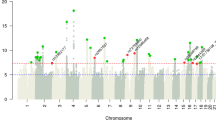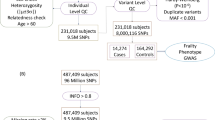Abstract
The definition of a precise and consistent aging phenotype that allows to measure the physical and cognitive decline, as well as the increase of mortality hazard late in life, is a major problem for studies aimed at finding the genetic factors modulating rate and quality of human aging. In this frame, it seems promising the concept of frailty which tends to figure out the subjects who are more vulnerable and more prone to negative outcomes, such as death or hospitalization. Cognitive, functional and psychological measures turned out to be the most effective measures to define frailty, as they condense most of the frailty cycle that occurs in the elderly and is probably responsible of the aging related physical decline. We used MMSE, Hand Grip strength, and GDS as variable parameters in a hierarchical Cluster Analysis (CA) in order to recognise aging phenotypes. By using a sample of 65–85 years old subjects we identified three frailty phenotypes that were consistent from both geriatric and genetic perspectives. Therefore, the method we propose may provide unbiased phenotypes suitable for the identification of genetic variants affecting the quality of aging in this age range. The CA method was less effective in ultranonagenarians, probably due to the high prevalence of frail subjects in this age group that makes difficult to distinguish discrete phenotypes.

Similar content being viewed by others
Abbreviations
- ADL:
-
Activity of Daily Living
- APOE:
-
Apolipoprotein E
- CA:
-
Cluster Analysis
- ECHA:
-
European Challenge for Healthy Ageing
- GDS:
-
Geriatric Depression Scale
- S1 :
-
Sample 1 (65–85 years old subjects)
- S2 :
-
Sample 2 (>90 years old subjects)
- MMSE:
-
Mini Mental State Examination
References
Atzmon G, Rincon M, Schechter CB, Shuldiner AR, Lipton RB, Bergman A, Barzilai N (2006) Lipoprotein genotype and conserved pathway for exceptional longevity in humans. PLoS Biol 4:e113
Bortz WM (2002) A conceptual framework of frailty: a review. J Gerontol A Biol Sci Med Sci 57:M283–M288
Carrieri G, Bonafe M, De Luca M, Rose G, Varcasia O, Bruni A, Maletta R, Nacmias B, Sorbi S, Corsonello F, Feraco E, Andreev KF, Yashin AI, Franceschi C, De Benedictis G (2001) Mitochondrial DNA haplogroups and APOE4 allele are non-independent variables in sporadic Alzheimer’s disease. Hum Genet 108:194–198
Christensen K, Johnson TE, Vaupel JW (2006) The quest for genetic determinants of human longevity: challenges and insights. Nat Rev Genet 7:436–448
Dato S, Carotenuto L, De Benedictis G (2006) Genes and longevity: a genetic-demographic approach reveals sex- and age-specific gene effects not shown by the case-control approach (APOE and HSP70.1 loci). Biogerontology (in press). doi: 10.1007/s10522-006-9030-1
Folstein MF, Folstein SE, McHugh PR (1975) “Mini-mental state.” A practical method for grading the cognitive state of patients for the clinician. J Psychiatr Res 12:189–198
Frederiksen H, McGue M, Jeune B, Gaist D, Nybo H, Skytthe AE, Vaupel JW, Christensen K (2002) Do children of long-lived parents age more successfully? Epidemiology 13:334–339
Fried LP, Tangen CM, Walston J, Newman AB, Hirsch C, Gottdiener J, Seeman T, Tracy R, Kop WJ, Burke G, McBurnie MA (2001) Frailty in older adults: evidence for a phenotype. J Gerontol A Biol Sci Med Sci 56:M146–M156
Fried LP, Ferrucci L, Darer J, Williamson JD, Anderson G (2004) Untangling the concepts of disability, frailty, and comorbidity: implications for improved targeting and care. J Gerontol A Biol Sci Med Sci 59:255–263
Gerdes LU, Jeune B, Ranberg KA, Nybo H, Vaupel JW (2000) Estimation of apolipoprotein E genotype-specific relative mortality risks from the distribution of genotypes in centenarians and middle-aged men: Apolipoprotein E gene is a ‘frailty gene’, not a ‘longevity gene’. Genet Epidemiol 19:202–210
Jeune B, Skytthe A, Cournil A, Greco V, Gampe J, Berardelli M, Andersen-Ranberg K, Passarino G, Debenedictis G, Robine JM (2006) Handgrip strength among nonagenarians and centenarians in three European regions. J Gerontol A Biol Sci Med Sci 61:707–712
Jones DM, Song X, Rockwood K (2004) Operationalizing a frailty index from a standardized comprehensive geriatric assessment. J Am Geriatr Soc 52:1929–1933
Jones D, Song X, Mitnitski A, Rockwood K (2005) Evaluation of a frailty index based on a comprehensive geriatric assessment in a population based study of elderly Canadians. Aging Clin Exp Res 17:465–471
Kang JH, Logroscino G, De Vivo I, Hunter D, Grodstein F (2005) Apolipoprotein E, cardiovascular disease and cognitive function in aging women. Neurobiol Aging 26:475–484
Katz S, Ford AB, Moskowitz RW, Jackson BA, Jaffe MW (1963) Studies of illness in the aged. The index of ADL: a standardized measure of biological and psychosocial function. JAMA 21:914–919
Lao JI, Montoriol C, Morer I, Beyer K (2005) Genetic contribution to aging: deleterious and helpful genes define life expectancy. Ann N Y Acad Sci 1057:50–63
McClearn GE, Johansson B, Berg S, Pedersen NL, Ahern F, Petrill SA, Plomin R (1997) Substantial genetic influence on cognitive abilities in twins 80 or more years old. Science 276:1560–1563
Melzer D, Dik MG, van Kamp GJ, Jonker C, Deeg DJ (2005) The apolipoprotein E e4 polymorphism is strongly associated with poor mobility performance test results but not self-reported limitation in older people. J Gerontol A Biol Sci Med Sci 60:1319–1323
Mitnitski AB, Graham JE, Mogilner AJ, Rockwood K (2002) Frailty, fitness and late-life mortality in relation to chronological and biological age. BMC Geriatr 27:1
Schachter F, Faure-Delanef L, Guenot F, Rouger H, Froguel P, Lesueur-Ginot L, Cohen D (1994) Genetic associations with human longevity at the APOE and ACE loci. Nat Genet 6:29–32
Sheikh JI, Yesavage JA (1986) Geriatric Depression Scale (GDS): recent evidence and development of a shorter version. clinical gerontology: a guide to assessment and intervention. NY, The Haworth Press, pp 165–173
Terry DF, Wilcox M, McCormick MA, Lawler E, Perls TT (2003) Cardiovascular advantages among the offspring of centenarians. J Gerontol A Biol Sci Med Sci 58:M425–M431
Terry DF, Wilcox MA, McCormick MA, Pennington JY, Schoenhofen EA, Andersen SL, Perls TT (2004) Lower all-cause, cardiovascular, and cancer mortality in centenarians’ offspring. J Am Geriatr Soc 52:2074–2076
Walston J, Hadley EC, Ferrucci L, Guralnik JM, Newman AB, Studenski SA, Ershler WB, Harris T, Fried LP (2006) Research agenda for frailty in older adults: toward a better understanding of physiology and etiology: summary from the American Geriatrics Society/National Institute on Aging Research Conference on Frailty in Older Adults. J Am Geriatr Soc 54:991–1001
Ward JH (1963) Hierarchical grouping to optimize an objective function. J Am Stat Assoc 58:236–244
Acknowledgments
The work was supported by Fondo Investimenti Ricerca di Base, FIRB 2001, by EU project “European Challenge for Healthy Aging” (No. QLRT-2001-00128, Call Identifier QOL-2001-3) (to G.D.B.) and by the Programmi di Ricerca Scientifica di Rilevante Interesse Nazionale, PRIN, 2004 (to G.P.).
Author information
Authors and Affiliations
Corresponding author
Rights and permissions
About this article
Cite this article
Passarino, G., Montesanto, A., De Rango, F. et al. A cluster analysis to define human aging phenotypes. Biogerontology 8, 283–290 (2007). https://doi.org/10.1007/s10522-006-9071-5
Received:
Accepted:
Published:
Issue Date:
DOI: https://doi.org/10.1007/s10522-006-9071-5




